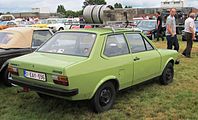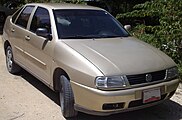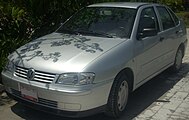VW Derby
| Volkswagen Derby | |
|---|---|
| Production period: | 1977-1985 |
| Class : | Small car |
| Body versions : | limousine |
| Successor: | VW Polo Classic |
The VW Derby was a small car developed by Audi in Ingolstadt for Volkswagen on the basis of the VW Polo and manufactured by Volkswagen from February 1977. The little sedan was basically a notchback Polo . The Group's sister model , the Audi 50 , provided the technical basis . The notchback variant remained in the VW range for two generations ( Polo I to Polo II ) from spring 1977 to early 1985.
Derby I (Type 86, 1977–1981)
| 1st generation | |
|---|---|
|
VW Derby (1977–1979) |
|
| Production period: | 1977-1981 |
| Body versions : | limousine |
| Engines: |
Petrol engines : 0.9-1.3 liters (29-44 kW) |
| Length: | 3836-3915 mm |
| Width: | 1560 mm |
| Height: | 1352 mm |
| Wheelbase : | 2335 mm |
| Empty weight : | 730 kg |
General
The first version of the Derby, presented in February 1977, corresponded to its sister model Polo up to the B-pillar . Instead of the hatchback with tailgate, the small sedan had a trunk that was quite large for the class (space for eight water tanks) with a normal trunk lid. The rear seat backs could not be folded down either. The notchback looked similar to the VW Jetta I , not from a single source.
The Derby also corresponded to the Polo in terms of motorization and equipment: the Derby, Derby S, Derby L, Derby LS and Derby GLS models were available. There was a choice of three different gasoline engines, all four-cylinder in-line:
- 895 cc, 40 PS (29 kW) at 5900 rpm.
- 1093 cc, 50 hp (37 kW) at 5600 rpm.
- 1272 cc, 60 PS (44 kW) at 5600 rpm.
All versions had a manual four-speed gearbox and front-wheel drive. In the 1.1 Formula E model , which was only offered in 1981 , the fourth gear had a particularly long ratio and the engine had a higher torque to offer. Both should help to save fuel.
Series production began on January 7, 1977 at the Volkswagen plant in Wolfsburg . In the first year of production in 1977, 72,412 units were sold, more than in the same period for the Polo. After that, the sales figures soon dropped significantly.
At the beginning of 1979 there was a slight facelift, which could be recognized by the bumpers now made of plastic. The interior of the dashboard has been revised and adapted to the Polo.
After almost five years of construction, the second generation of the Derby was presented at the end of 1981.
| VW Derby / Polo | 0.9 | 1.1 | 1.1 Formula E (1981) |
1.3 (1977-1981) |
|---|---|---|---|---|
| engine | 4- cylinder in - line engine ( four-stroke ) | |||
| Displacement | 895 cm 3 | 1093 cm 3 | 1272 cm 3 | |
| Bore × stroke | 69.5 × 59 mm | 69.5 × 72 mm | 75 × 72 mm | |
| Power at 1 / min | 29 kW (40 hp) at 5900 | 37 kW (50 PS) at 5600 | 44 kW (60 hp) at 5600 | |
| Max. Torque at 1 / min | 61 Nm at 3500 | 75 Nm at 3500 | 80 Nm at 3300 | 93 Nm at 3400 |
| Mixture preparation | 1 downdraft carburetor | |||
| Valve control | Toothed belt, overhead camshaft , rocker arm | |||
| cooling | Water cooling | |||
| transmission | Four-speed transmission | |||
| Front suspension | MacPherson struts, wishbones | |||
| Rear suspension | Coupling link axle , suspension struts | |||
| Brakes | Discs in front, drums in the back | |||
| body | Sheet steel, self-supporting | |||
| Front / rear track | 1296/1312 mm | |||
| wheelbase | 2335 mm | |||
| length | 3836-3915 mm | |||
| Empty weight | 730 kg | |||
| Top speed | 132-135 km / h | 141-144 km / h | 152 km / h | |
| Acceleration (0-100 km / h) | 21 s | 18 s | 17 s | 15 s |
| Consumption (liters / 100 km) | 8.5 N | 9.0 N | 8.5 S. | 10.0 N |
Derby II (Type 86C, 1981–1985)
| 2nd generation | |
|---|---|
|
VW Derby (1981–1985) |
|
| Production period: | 1981-1985 |
| Body versions : | limousine |
| Engines: |
Petrol engines : 1.05–1.3 liters (29–44 kW) |
| Length: | 3975 mm |
| Width: | 1580-1600 mm |
| Height: | 1355 mm |
| Wheelbase : | 2335 mm |
| Empty weight : | 770-800 kg |
General
The second derby resulted from a major overhaul. Like the Polo II, it also got plastic bumpers and a new radiator grille. Unlike the sister model, this time the headlights were rectangular. In addition to new taillights, there was also a different range of engines:
- 1035 cm³, 40 PS (29 kW) at 5300 rpm.
- 1093 cc, 50 hp (37 kW) at 5600 rpm.
- 1272 cc, 60 PS (44 kW) at 5600 rpm. (until 07.1983)
- 1272 cc, 55 PS (40 kW) at 5400 rpm. (from 08.1983)
The 1.1 Formula E was also retained until the end of 1983 and replaced by the 1.3 Formula E from the beginning of 1984 . The models Derby C, Derby CL and Derby GL were available.
After only 5,044 copies of the Derby could be sold in 1984, it was given the name of the base model in January 1985 (at the same time as the notchback offshoot Santana of the Passat ). The derby was renamed Polo and got round headlights again.
Between November 1981 and January 1985, a total of almost 370,000 copies were produced under the name Derby.
| VW Derby | 1.0 (1981-1985) |
1.1 (1981-1983) |
1.1 Formula E (1981–1983) |
1.3 (1981-1983) |
1.3 (1983-1985) |
1.3 Formula E (1984–1985) |
|---|---|---|---|---|---|---|
| engine | 4- cylinder in - line engine ( four-stroke ) | |||||
| Displacement | 1035 cm 3 | 1093 cm 3 | 1272 cm 3 | |||
| Bore × stroke | 75 × 59 mm | 69.5 × 72 mm | 75 × 72 mm | |||
| Power at 1 / min | 29 kW (40 hp) at 5300 | 37 kW (50 PS) at 5600 | 44 kW (60 hp) at 5600 | 40 kW (55 PS) at 5400 | ||
| Max. Torque at 1 / min | 73 Nm at 2700 | 75 Nm at 3500 | 80 Nm at 3300 | 93 Nm at 3500 | 94 Nm at 3400 | |
| Mixture preparation | 1 downdraft carburetor | 1 register downdraft carburetor | ||||
| Valve control | OHC , timing belt | |||||
| cooling | Water cooling | |||||
| transmission | Four-speed transmission | |||||
| Front suspension | MacPherson struts, wishbones | |||||
| Rear suspension | Coupling link axle , suspension struts | |||||
| Brakes | Discs in front, drums in the back | |||||
| body | Sheet steel, self-supporting | |||||
| Front / rear track | 1306/1332 mm | |||||
| wheelbase | 2335 mm | |||||
| length | 3975 mm | |||||
| Empty weight | 715-800 kg | |||||
| Top speed | 135 km / h | 148 km / h | 155 km / h | 153 km / h | 155 km / h | |
| Acceleration (0-100 km / h) | 19 s | 16 s | 17 s | 15 s | 14.5 s | 15 s |
| Consumption (liters / 100 km) | 8.5 N | 9.0 N | 8.5 S. | 10.0 N | 8.0 N | 7.5 N / S |
Successor models
However, the renaming could not stop the deep fall in the favor of customers, which is why the Polo notchback was removed from the range in Germany in August 1988. In addition, the revised model of the VW Polo II (internal designation 2F) offered from October 1990 was no longer offered as a notchback in Germany, but was only available as a reimport. With the exception of the bumper, the rear of the Polo Classic was not adapted to the other models, but remained that of the predecessor, recognizable, among other things, by the use of the old "Polo" lettering.
Only the successor Polo III (6N) received a notchback version again, the now four-door Polo Classic. However, it was an externally modified Seat Cordoba , the notchback version of the Seat Ibiza . This shared a technical basis with the Polo 6N, for example the same dashboard. However, it was not a great success either. Nevertheless, Volkswagen also launched a notchback model based on the Polo IV (9N) . It was an import from Brazil.
Here, too, there was no success, so that this variant disappeared from the German market with the facelift of the Polo 9N in May 2005. The notchback variant is still produced and sold abroad.
In Mexico, the Polo Classic, based on the VW Polo 6N, will continue to be sold under this name.
Volkswagen Derby (1999-2005)
swell
- Werner Oswald: Deutsche Autos 1945-1990 , Vol. 3, Motorbuch Verlag, Stuttgart 2003, ISBN 3-613-02116-1 , pp. 68–71 and 104–113.
Individual evidence
- ↑ a b c d e f Werner Oswald: German cars 1945–1990 . Volume 3. Motorbuch Verlag, Stuttgart 2001. ISBN 3-613-02116-1 . Pp. 68-71
- ^ Wolfsburg News. Edition of January 7, 2017, p. 17.
- ↑ a b c d e f Werner Oswald: German cars 1945–1990 . Volume 3. Motorbuch Verlag, Stuttgart 2001. ISBN 3-613-02116-1 . Pp. 104-113









